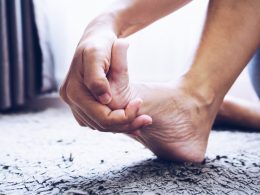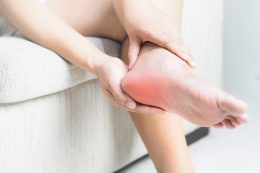Filed under Heel Pain …
What are Some Nonsurgical Options for Plantar Fasciitis?
Reviewing Your Noninvasive Options for Pain Relief
Our feet already endure daily wear and tear while performing daily activities such as walking, running, and jumping. It should come as no surprise that some people may develop plantar fasciitis, which occurs when the plantar fascia ligament in your foot becomes inflamed and causes sharp, stabbing heel pains. While most cases resolve within a year with or without treatment, there are a few nonsurgical treatment options that you can use to relieve the pain.
Stretching
Stretching is an essential part of any plantar fasciitis treatment. Tight muscles in your calves and foot arches can make symptoms worse, but you can soothe or prevent the pain by performing a few easy lower body stretches. Calf stretches target the gastrocnemius muscle, which is located on the back portion of your lower leg, and arch stretches stretch the middle of your foot.
You can stretch your calves by standing an arm’s length from a wall, placing your right foot behind your left, and then slowly and gently bend your left leg forward. As you lean forward, keep your right knee steady and your right heel planted firmly on the ground. Hold the stretched position for at least 15 seconds and release before reversing the position of your legs. Repeat each side three times.
To stretch your arches, you can perform a few seated stretching exercises. One easy movement is to roll your foot back and forth over a foam roller or frozen beverage bottle for one minute per foot before crossing one leg over the other and grabbing your big toe, gently putting it toward you for 30 seconds. Repeat three times per foot.
Alternatively, you can place a resistance band or folded towel under both of your arches and gently pull the tops of your feet toward you, holding for 15 to 30 seconds for three repetitions.
Pain Relief Medication
In addition to techniques such as ice massages, over-the-counter pain relievers are one option for reducing pain and discomfort caused by plantar fasciitis. Nonsteroidal anti-inflammatory drugs such as ibuprofen, aspirin, or acetaminophen are all popular options for controlling the pain.
Alternatively, if your symptoms are severe enough to impact your quality of life, you may consider corticosteroid injections in the tissues near your heel bone, which can provide rapid pain relief that may last for weeks. For long-term pain relief, botulinum toxin injections can relieve pain for months. It is important to note that though corticosteroid injections can interfere with the healing process, botulinum toxin injections do not.
Physical Therapy
Research shows that customized physical therapy programs can be a highly effective treatment option for plantar fasciitis. Treatment can include ice applications and strengthening exercises that can improve walking and significantly reduce pain. Heel raises, ankle inversions, and plantar fascia stretches are examples of standard physical therapy exercises that you can do at home and in therapy.
Night Splints
Night splints stretch your calves and foot arches while you’re sleeping, which can help lower heel pain first thing in the morning. Additionally, taping your foot can support your arch, reduce strain, and correct overpronation throughout your day.
Orthotic Shoe Inserts
Orthotic shoe inserts can help restore natural gait with arch support and heel cups. Inserts also help distribute pressure evenly when you are walking or running, reducing the stress on your plantar fascia.
Compression Socks
Compression socks are one effective option for treating plantar fasciitis, which puts mild to moderate pressure on your heel and provides arch support. Compression socks are available in multiple styles, including ankle or knee-highs, which can also compress your calves, as well as numerous uses. For instance, certain brands are better suited for athletic activity, while others are more viable for long periods of standing.
Supportive Footwear
Patients with plantar fasciitis often require supportive footwear for achieving maximum comfort during physical activity. While there is no “one-size-fits-all” solution when it comes to footwear, there are many options available to choose from in running shoes, walking shoes, hiking shoes, and sandals.
Losing Weight
Obesity or excess body weight is a considerable risk factor in developing plantar fasciitis due to the added stress that extra weight puts on your plantar fascia. Losing weight can not only reduce any pressure on your feet but can also make you feel better about yourself all around.
For most cases, the standard treatment for plantar fasciitis is plenty of rest, stretching, pain relief medications, ice massages, orthotics, and low-impact exercises for strengthening your muscles and maintaining your weight. Chronic and deliberating cases may require more extensive nonsurgical treatment options, such as injections or regenerative medicine.
Get Plantar Fasciitis Treatment in Maryland
If you are in Maryland looking for Plantar Fasciitis treatment, make an appointment with us today.
Severe Heel Pain – What Can You Do?
You’ll know severe heel pain when you feel it. Though it can be caused by multiple underlying factors, the result is the same: an intense discomfort or pain that can interrupt your quality of life.
Fortunately, with a podiatrist’s help, you can explore treatment options to both address the root cause and eliminate or reduce the discomfort you feel.
Common Causes of Severe Heel Pain
Plantar Fasciitis
Also known as “heel spur syndrome,” plantar fasciitis is often the most common cause of heel pain. This condition occurs when the foot’s plantar fascia (the tissue between your heel and toes) becomes inflamed. People with high-arched feet are more susceptible to developing plantar fasciitis.
The most common symptom of plantar fasciitis is physical pain at the bottom of the heel or the arch of the foot. This pain may also worsen upon standing or increase over a period of months. Patients living with this condition should also monitor their heels for any swelling.
In some extreme cases, plantar fasciitis will require surgery to correct. However, most instances can be treated with nonsurgical options, such as:
- Stretching the calf muscles
- Wearing supportive footwear or modifying your shoes
- Icing the heel
- Medications
If these milder treatments do not work, your podiatrist might recommend other options like custom orthotic inserts, a removable cast, a night splint, or physical therapy.
Heel Sprain, Strain, and Fracture
Intense physical activity can cause a sprain or strain in the heel. Most often, this can be treated by resting the foot, using ice to reduce inflammation, compressing the area, and elevating it as much as possible.
If the heel bone is fractured, urgent treatment may be required. In these cases, we recommend visiting your nearest emergency room as soon as possible for immediate attention.
Achilles Tendonitis
Your Achilles tendon runs between your calf and your heel. If the tendon is injured, this can cause intense pain and it should be examined by a podiatrist as soon as possible.
Tarsal Tunnel Syndrome
Tarsal tunnel syndrome occurs when a nerve at the back of your foot is injured. This compression neuropathy can affect both the ankle joint and the foot itself.
Other Conditions
Other conditions that may also contribute to heel pain include:
- Bursitis
- Ankylosing spondylitis
- Osteochondroses
- Reactive arthritis
- Heel bumps (common in adolescents)
Heel Pain Diagnosis
Heel pain itself is not a medical condition, but a symptom of something else. When visiting a podiatrist, they can examine the heel and determine the root issue.
Heel Pain Treatment
Because heel pain can result from many different underlying conditions, treatment options vary. Generally, however, these are some best practices that you can put into place to help promote healthy recovery:
Take it Easy
Your foot is a hardworking part of the body. Give it a rest and try to elevate it as much as possible. While you’re recovering, try to find some enjoyable activities you can do in a sedentary position to limit your walking.
Avoid Running
Similar to above, avoid running while in recovery. Running can place a great deal of stress on the heel.
If Sore, Ice and Elevate
If your heel feels sore after beginning treatment, continue to ice and elevate regularly. This will help keep the inflammation down and free the heel from any pressure.
Monitor the Heel for Any Changes
Pay attention to the healing process. Do you feel the pain lessening or worsening? If the latter, be sure to contact your podiatrist as soon as possible and let them know that the condition is persisting.
Long Term Prevention for Severe Heel Pain
If your pain is caused by a common suspect like plantar fasciitis, consider buying shoe inserts made specifically for the condition. You can buy these at the pharmacy or ask your podiatrist if they sell or recommend higher-end options. These inserts provide additional support and cushioning to the foot’s arch to reduce the stress you are placing on the tissue.
After receiving a diagnosis and undergoing treatment, ask your podiatrist for condition-specific advice to prevent the heel pain from reoccurring. Depending on your specific case, they can provide specialized recommendations and answer any questions you might have specific to your lifestyle.
Are You Experiencing Heel Pain? Let Us Help
We have helped many Maryland residents experiencing heel pain in treating and recovering from underlying conditions associated with this painful symptom. If you are experiencing severe heel pain and would like to connect with one of our specialists, please contact us anytime or request an appointment.







